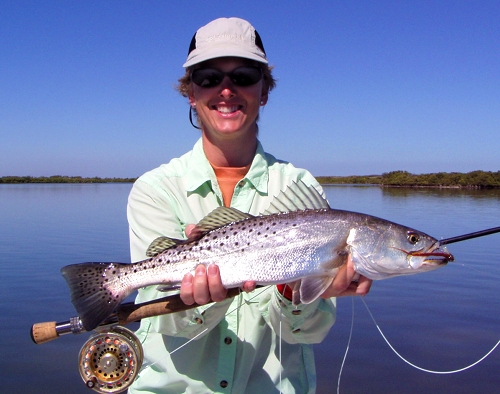The wind blows from the south under a gray sky. A squall line approaches from the north. That south wind dies. It’s eerily calm. Suddenly a frigid blast comes from the north. Rain lashes, whitecaps crash, the temperature drops 20 degrees in seconds. A common winter phenomenon, a cold front has just passed through.
How does the passing of a cold front affect the flats fisherman?
Unlike you, fish are cold blooded. A fish’s body temperature hovers within a degree or two of their surroundings. Redfish prefer 70 degree water. Spotted seatrout like it between 70 and 75 degrees.
As temperatures get below that their metabolic processes slow. They need less food. Get near the extremes of their tolerance and they become lethargic. Another degree or two colder and they die. We saw this demonstrated two winters ago during that extended cold snap. Dead fish were everyplace.
During the winter months, water temperatures in our local lagoons rarely get as warm as the fish prefer. Our finned friends seek water temperatures as close to their preferred range as they can find. Since shallow water warms (and cools) more quickly than does deep water, when conditions are right the shallows will be full of fish.
Right after a cold front passes the conditions are not right.
The passage of the front causes the air temperature to drop, which in turn lowers the water temperature. This drop in water temperature is exacerbated by a strong northwest wind, often at 20 to 25 miles per hour with higher gusts. An interested observer can stand on the bank at the north end of the lagoon system and over the course of several hours literally watch the water level drop as the wind blows the water to the south.
Fishing the flats during these conditions is a complete waste of time. The fish have moved to thermal refuges where their bodies can better adjust to the falling water temperatures. In the deeper water the temperature will still drop, but it occurs more gradually. This causes less shock to the fish.
These thermal refuges include canals, dredge holes, power plant outflows, and perhaps the Intracoastal Waterway channel. Just the mass of water in these types of places supplies some insulation and moderates the temperatures. If you find a concentration of fish in this situation fishing can be ridiculously easy.
The fish don’t find much in the way of groceries in these types of places, though. The groceries are up on the flats. This brings us back to a statement made above: when conditions are right the shallows will be full of fish…
To read the rest of this article, please visit this link.
John Kumiski
http://www.spottedtail.com
All content in this blog, including writing and photos, copyright John Kumiski 2011. All rights are reserved.

Recent Comments